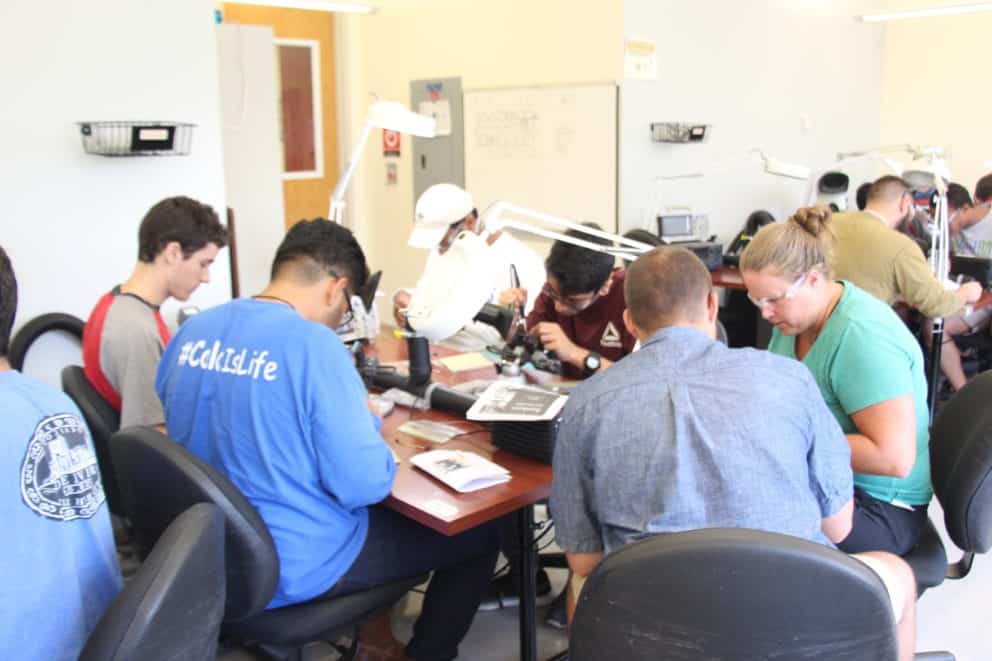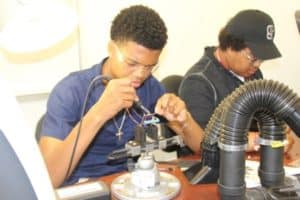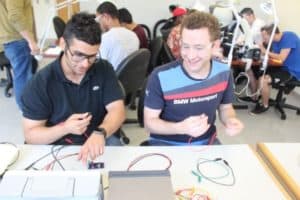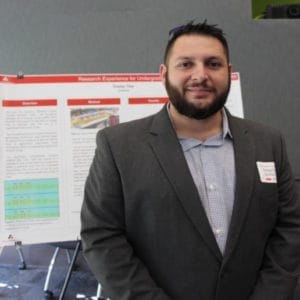
A group of students huddled around tables in a lab at N.C. State University one hot summer day in late July, peering through plastic goggles as they soldered components onto printed circuit boards. The finished boards would operate as power converters. Through the exercise, they were getting a crash course in wide bandgap power electronics, specifically, how silicon carbide and gallium nitride – two compounds that enable power electronics to operate highly efficiently – stacked up against silicon, which is the standard, less efficient material widely used in power electronics today.
At the end of the exercise, students tested their boards with oscilloscopes, which display electric currents on a screen, and multi-meters, which measure them. “As you can see, the gallium nitride-based power converter operates at higher frequencies and efficiencies,” said lab instructor and PhD student Alireza Dayerizadeh. The students looked on, nodding their head in agreement. You could practically see the wheels of their brain turning as the knowledge sunk in.
Lab exercises such as these are just one component of the Research Experience for Undergraduates (REU), offered by FREEDM and PowerAmerica for 10 weeks each summer. The goal? To get students familiar with power electronics – with a focus on wide bandgap technology. Both centers strive to accelerate the development and adoption of these highly efficient power electronics systems, thus saving energy on a large scale and driving a stronger advanced manufacturing industry in the U.S. Getting the next generation of workers prepped to lead this charge is a vital part of fulfilling this goal.

The REU program is unique in that it offers a crash course in a variety of skills not necessarily obtained in a traditional classroom. It’s also unique in the students it attracts. The program pulls not just from four-year schools, but from community colleges in the surrounding region – reaching students who wouldn’t otherwise have access to the research and labs at a large, well-funded research institution like N.C. State University. For six weeks, REU students are joined by high school students and teachers from surrounding counties – the “pre-college” component of the summer education programs. This summer, 20 undergraduates, high school students and teachers participated.
PowerAmerica and FREEDM also offer an additional program – the Undergraduate Research Scholars Program (UGRS) – that runs through the academic year. Students come from partner universities and are assigned to a project sponsored by PowerAmerica, FREEDM, The National Science Foundation, Duke Energy, and the NC State College of Engineering.
Not all the students are entering the electrical engineering field, either. This summer’s class included students pursuing degrees in mechanical, computer science and aerospace engineering. The takeaway is that knowledge in power electronics is useful to a variety of research fields, and the diverse backgrounds only add to the program, said Pam Carpenter, Director of Education and Workforce Development for FREEDM and Power America. “There are so many different skillsets coming together that it sets the students up for success, and also helps academic researchers – it’s a win-win for everyone,” Carpenter said.
The course content for all programs is similar, although UGRS is administered remotely. In addition to weekly labs – featuring a wide variety of topics, from electric vehicles to wide bandgap to circuits to coding, as well as software like SolidWorks and MatLab – students attend sessions on skills they may or may not have been taught in a classroom, like how to communicate their research and research ethics.
Sean Clark, a Wake Tech student who will transfer into N.C. State’s aerospace engineering undergraduate program this fall, applied for the program as a way to become more comfortable with electronics, hardware and wide bandgap. “Everything overlaps, and I thought it was a great opportunity to learn more about all of them,” he said. Clark said learning the ins and outs of software such as Simulink and MATLAB was probably the most beneficial part of the program, as well as learning presentation skills and how to effectively pitch his work.

Hands-On Research
Perhaps the most significant component of the curriculum for many students is getting assigned to assist with a project funded by either PowerAmerica or the FREEDM Systems Center, PowerAmerica and FREEDM merged their Education and Workforce programs in 2017.
Undergraduate classes are often heavy on theory – which is a critical component to any discipline – but adding the research experience helps students apply the theory in a research environment. said Carpenter, the EWD program director. Participating in hands-on research with a team – including the project principal investigator, a graduate mentor and other students – helps the students learn skills like collaboration, teamwork, leadership and project management. It also gives them a frame of reference for other skills they learn in the program, like communicating their subject matter.
“Research is often messy and ill-defined, so having a support system in place – like the type offered by our summer program – is significant to setting the student up for success,” Carpenter said. What she means is that the research process can involve multiple failures and lots of experimentation, with a good bit of problem solving and critical thinking along the way – challenges that the students learn to confront effectively by learning from a more experienced team, as well as each other.
Cristian Melara, a student in N.C. State’s College of Electrical and Computer Engineering, studied more affordable ways to manufacture silicon carbide. He teamed up with PowerAmerica researcher Dr. Jay Baliga, a professor at N.C. State who has designed a silicon carbide wafer production process being utilized at the X-FAB Foundry in Lubbock, Texas. Over the summer, Melara tested the wafers being manufactured at X-FAB to see how well the process is working, cataloguing data to help with future wafer production. Working with a researcher who is pioneering the next generation of power electronics, and actually having a hand in testing his product, was invaluable, Melara said.
“The more I went through this program, the more I really came to believe and understand that silicon carbide has the ability to revolutionize power electronics, and technology across the board. It’s been a great experience,” Melara said.
Gregorio Sanford, a military veteran and former commercial diver who learned about the REU program when Dr. Carpenter, the program director, came to his class at Wake Tech Community College to encourage students to apply. He gained opportunities from the program that will be a valuable asset to his career down the road, namely the chance to submit a paper to the Advanced Power Electronics Power Conference on his project, dynamic wireless power transfer for industrial applications. “It’s not every day that an undergraduate student gets an opportunity to submit, and be the lead author on, a scholarly article,” Sanford said.
Providing new opportunities for students that they can’t get elsewhere is a major goal of the program, said Megan Morin, Carpenter’s graduate assistant. “At the end, students will have built something, worked with something or done something they’ve never done before.”

Program Successes + Looking Ahead
Students leave the programs with a heightened understanding of power electronics, which is documented in exit surveys conducted by Carpenter and her team. For example, they saw a 30% improvement in the scores of students – both undergraduate and high school, as well as teachers – who were asked, “What is a wide bandgap semiconductor?”
Morin is able to point to other program successes, too. “We’re seeing students transfer in from community college to a four-year school, as well as a higher interest in graduate school after this program. We’re seeing increased confidence, and the ability to speak effectively about their research.”
Back in the early ‘00s, the National Academy of Engineering defined the skills that would be needed for an engineer in 2020 to be successful. These include thinking outside the box, being creative, knowing how to communicate their work, and being able to adapt to the unexpected.
Carpenter cites this standard when she talks about the goals for the education and workforce program, and the importance of offering something students can’t get elsewhere to equip them for jobs in power electronics and other advanced manufacturing fields. “It’s important for our program to have the best, emerging practices for students preparing to be engineers,” she said.
It’s also important to include everyone, Carpenter said. A quarter of this year’s summer program students came from community colleges, and nearly half were from underrepresented populations. Carpenter would like to increase those numbers.
In addition, Carpenter sees the programs as a way to introduce students to a career path in manufacturing they may not have seriously considered before.
“Interest in advanced manufacturing is an issue nationally, because the manufacturing that these students’ parents and grandparents knew went away. So it’s about changing the equation and building awareness and knowledge about the opportunities that are out there now,” Carpenter said.

This article is adapted from an original post written by Julia Casadonte, Power America Communications Manager. Read the original article here.
